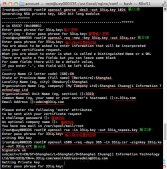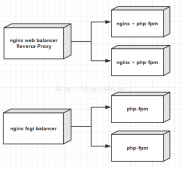- upstream 定义负载节点池。
- location 模块 进行URL匹配。
- proxy模块 发送请求给upstream定义的节点池。
upstream模块解读
nginx 的负载均衡功能依赖于 ngx_http_upstream_module模块,所支持的代理方式有 proxy_pass(一般用于反向代理),fastcgi_pass(一般用于和动态程序交互),memcached_pass,proxy_next_upstream,fastcgi_next_pass,memcached_next_pass 。
upstream 模块应该放于http{}标签内。
模块写法:
|
1
2
3
4
5
6
7
|
upstream backend { ip_hash; server backend1.example.com weight=5; server backend2.example.com:8080; server backup1.example.com:8080 backup; server backup2.example.com:8080 backup;} |
实例一:
|
1
2
3
4
5
6
7
8
9
10
11
|
upstream dynamic { zone upstream_dynamic 64k; server backend1.example.com weight=5; server backend2.example.com:8080 fail_timeout=5s slow_start=30s; server 192.0.2.1 max_fails=3; server backend3.example.com resolve; server backup1.example.com:8080 backup; server backup2.example.com:8080 backup;} |
语法解释:
nginx默认支持四种调度算法
- 轮询(rr),每个请求按时间顺序逐一分配到不同的后端服务器,如果后端服务器故障,故障系统自动清除,使用户访问不受影响。
- 轮询权值(weight),weight值越大,分配到的访问几率越高,主要用于后端每个服务器性能不均的情况。
- ip_hash,每个请求按访问IP的hash结果分配,这样来自同一个IP的固定访问一个后端服务器,主要解决动态网站session共享的问题。
- url_hash,按照访问的URL的hash结果来分配请求,是每个URL定向到同一个后端服务器,可以进一步提高后端缓存服务器的效率,nginx本身不支持,如果想使用需要安装nginx的hash软件包。
- fair,这个算法可以依据页面大小和加载时间长短智能的进行负载均衡,也就是根据后端服务器的响应时间来分配请求,相应时间短的优先分配,默认不支持,如果想使用需要安装upstream_fail模块。
- least_conn 最少链接数,那个机器连接数少就分发。
server模块的写法
server IP 调度状态
server指令指定后端服务器IP地址和端口,同时还可以设定每个后端服务器在负载均衡调度中的状态。
- down 表示当前的server暂时不参与负载均衡。
- backup 预留的备份服务器,当其他所有的非backup服务器出现故障或者忙的时候,才会请求backup机器,因为这台集群的压力最小。
- max_fails 允许请求失败的次数,默认是1,当超过最大次数时,返回proxy_next_upstream模块定义的错误。0表示禁止失败尝试,企业场景:2-3.京东1次,蓝汛10次,根据业务需求去配置。
fail_timeout,在经历了max_fails次失败后,暂停服务的时间。京东是3s,蓝汛是3s,根据业务需求配置。常规业务2-3秒合理。
例:如果max_fails是5,他就检测5次,如果五次都是502.那么,他就会根据fail_timeout 的值,等待10秒,再去检测。
server 如果接域名,需要内网有DNS服务器,或者在负载均衡器的hosts文件做域名解析。server后面还可以直接接IP或IP加端口。
长连接 keepalive
|
1
2
3
4
5
|
upstream backend { server backend2.example.com:8080; server backup1.example.com:8080 backup; keepalive 100;} |
通过该指令配置了每个worker进程与上游服务器可缓存的空闲连接的最大数量。
当超出这个数量时,最近最少使用的连接将被关闭。keepalive指令不限制worker进程与上游服务器的总连接。
|
1
2
3
4
5
6
|
location / { # 支持keep-alive proxy_http_version 1.1; proxy_set_header Connection ""; proxy_pass http://backup;} |
- 如果是http/1.0 需要配置发送"Connection: Keep-Alive" 请求头。
- 上游服务器不要忘记开启长连接支持。
连接池配置建议
- 总长连接数是"空闲连接池"+"释放连接池"的长连接总数。
- 首先,长连接配置不会限制worker进程可以打开的总连接数(超了的作为短连接)。另外连接池一定要根据场景合理进行设置。
空闲连接池太小,连接不够用,需要不断建连接。
空闲连接池太大,空闲连接太多,还没使用就超时。
建议只对小报文开启长连接。
location 模块解读
location作用:基于一个指令设置URI。
基本语法:
|
1
2
3
4
|
Syntax: location [ = | ~ | ~* | ^~ ] uri { ... }location @name { ... }Default: —Context: server, location |
- = 精确匹配,如果找到匹配=号的内容,立即停止搜索,并立即处理请求(优先级最高)
- ~ 区分大小写
- ~* 不区分大小写
- ^~ 只匹配字符串,不匹配正则表达式
- @ 指定一个命名的location,一般用于内部重定义请求,location @name {…}
匹配是有优先级的,不是按照nginx的配置文件进行。
官方的例子:
|
1
2
3
4
5
6
7
8
9
10
11
12
13
14
15
|
location = / { [ configuration A ]}location / { [ configuration B ]}location /documents/ { [ configuration C ]}location ^~ /images/ { [ configuration D ]}location ~* \.(gif|jpg|jpeg)$ { [ configuration E ]} |
结论:
- / 匹配A。
- /index.html 匹配B
- /documents/document.html 匹配C
- /images/1.gif 匹配D
- /documents/1.jpg 匹配的是E。
测试用的例子:
|
1
2
3
4
5
6
7
8
9
10
11
12
13
14
15
|
location / { return 401; } location = / { return 402; } location /documents/ { return 403; } location ^~ /images/ { return 404; } location ~* \.(gif|jpg|jpeg)$ { return 500; } |
测试结果(重点看):
|
1
2
3
4
5
6
7
8
9
10
|
[root@lb01 conf]# curl -I -s -o /dev/null -w "%{http_code}\n" http://10.0.0.7/402[root@lb01 conf]# curl -I -s -o /dev/null -w "%{http_code}\n" http://10.0.0.7/index.html401[root@lb01 conf]# curl -I -s -o /dev/null -w "%{http_code}\n" http://10.0.0.7/documents/document.html 403[root@lb01 conf]# curl -I -s -o /dev/null -w "%{http_code}\n" http://10.0.0.7/images/1.gif404[root@lb01 conf]# curl -I -s -o /dev/null -w "%{http_code}\n" http://10.0.0.7/dddd/1.gif 500 |
结果总结:
匹配的优先顺序,=>^~(匹配固定字符串,忽略正则)>完全相等>~*>空>/ 。
工作中尽量将'='放在前面
proxy_pass 模块解读
proxy_pass 指令属于ngx_http_proxy_module 模块,此模块可以将请求转发到另一台服务器。
写法:
proxy_pass http://localhost:8000/uri/;
实例一:
|
1
2
3
4
5
6
7
8
9
10
11
12
13
|
upstream blog_real_servers { server 10.0.0.9:80 weight=5; server 10.0.0.10:80 weight=10; server 10.0.0.19:82 weight=15;}server { listen 80; server_name blog.etiantian.org; location / { proxy_pass http://blog_real_servers; proxy_set_header host $host; }} |
- proxy_set_header:当后端Web服务器上也配置有多个虚拟主机时,需要用该Header来区分反向代理哪个主机名,proxy_set_header host $host;。
- proxy_set_header X-Forwarded-For :如果后端Web服务器上的程序需要获取用户IP,从该Header头获取。proxy_set_header X-Forwarded-For $remote_addr;
配置后端服务器接收前端真实IP
配置如下:
|
1
2
3
|
log_format commonlog '$remote_addr - $remote_user [$time_local] "$request" ' '$status $body_bytes_sent "$http_referer" ' '"$http_user_agent" "$http_x_forwarded_for"'; |
rs_apache节点的httpd.conf配置
|
1
2
3
4
|
LogFormat "\"%{X-Forwarded-For}i\" %l %u %t \"%r\" %>s %b \"%{Referer}i\" \"%{User-Agent}i\"" combined修改日志记录apacheLogFormat "\"%{X-Forwarded-For}i\" %l %u %t \"%r\" %>s %b" common |
proxy_pass相关的优化参数
- client_max_body_size 10m; 允许客户端请求的最大的单个文件字节数。
- client_body_buffer_size 128k; 缓冲区代理缓冲用户端请求的最大字节数 可以理解为先保存到本地再传给用户。
- proxy_connect_timeout 600; 跟后端服务器连接的超时时间_发起握手等候响应超时时间。
- proxy_read_timeout 600; 连接成功后_等候后端服务器响应时间_其实已经进入后端的排队之中等候处理。
- proxy_send_timeout 600; 后端服务器回传数据时间,就是在规定时间之内后端服务器必须传完所有的数据。
- proxy_buffer_size 8k; 代理请求缓存区,这个缓存区间会保存用户的头信息以供Nginx进行规则处理,一般只要设置能保存下头信息即可。
- proxy_buffers 4 32k; 同上 告诉Nginx保存单个页面使用的空间大小,假设网页大小平均在32k以下的话。
- proxy_busy_buffers_size 64k; 如果系统很忙的时候可以申请更大的proxy_buffers 官方推荐(proxy_buffers*2)。
- proxy_max_temp_file_size 1024m; 当 proxy_buffers 放不下后端服务器的响应内容时,会将一部分保存到硬盘的临时文件中,这个值用来设置最大临时文件大小,默认1024M,它与 proxy_cache 没有关系。大于这个值,将从upstream服务器传回。设置为0禁用。
- proxy_temp_file_write_size 64k; proxy缓存临时文件的大小 proxy_temp_path(可以在编译的时候)指定写到哪那个目录。
健康检查
Nginx提供了health_check语句来提供负载(upstream)时的键康检查机制(注意:此语句需要设置在location上下文中)。
支持的参数有:
- interval=time:设置两次健康检查之间的间隔值,默认为5秒
- fails=number:设置将服务器视为不健康的连续检查次数,默认为1次
- passes=number:设置一个服务器被视为健康的连续检查次数,默认为1次
- uri=uri:定义健康检查的请求URI,默认为”/“
- match=name:指定匹配配置块的名字,用记测试响应是否通过健康检测。默认为测试返回状态码为2xx和3xx
一个简单的设置如下,将使用默认值:
|
1
2
3
4
|
location / { proxy_pass http://backend; health_check;} |
对就应用,我们可以专门定义一个API用于健康检查:/api/health_check,并只返回HTTP状态码为200。并设置两次检查之间的间隔值为1秒。这样,health_check语句的配置如下:
|
1
|
health_check uri="/api/health_check" interval; |
匹配match的方法
|
1
2
3
4
5
6
7
8
9
10
11
12
13
14
15
|
http { server { ... location / { proxy_pass http://backend; health_check match=welcome; } } match welcome { status 200; header Content-Type = text/html; body ~ "Welcome to nginx!"; }} |
match 例子举例
- status 200;: status 等于 200
- status ! 500;: status 不是 500
- status 200 204;: status 是 200 或 204
- status ! 301 302;: status 不是301或302。
- status 200-399;: status 在 200 到 399之间。
- status ! 400-599;: status 不在 400 到 599之间。
- status 301-303 307;: status 是 301, 302, 303, 或 307。
- header Content-Type = text/html;: “Content-Type” 得值是 text/html。
- header Content-Type != text/html;: “Content-Type” 不是 text/html。
- header Connection ~ close;: “Connection” 包含 close。
- header Connection !~ close;: “Connection” 不包含 close。
- header Host;: 请求头包含 “Host”。
- header ! X-Accel-Redirect;: 请求头不包含 “X-Accel-Redirect”。
- body ~ "Welcome to nginx!";: body 包含 “Welcome to nginx!”。
- body !~ "Welcome to nginx!";: body 不包含 “Welcome to nginx!”。
一个完整的nginx实例
|
1
2
3
4
5
6
7
8
9
10
11
12
13
14
15
16
17
18
19
20
21
22
23
24
25
26
27
28
29
30
31
32
33
34
|
[root@lb01 conf]# cat nginx.confworker_processes 1;events { worker_connections 1024;}http { include mime.types; default_type application/octet-stream; sendfile on; keepalive_timeout 65; #blog lb by oldboy at 201303 upstream blog_real_servers { server 10.0.0.9:80 weight=1 max_fails=1 fail_timeout=10s; server 10.0.0.10:80 weight=1 max_fails=2 fail_timeout=20s; } server { listen 80; server_name blog.etiantian.org; location / { proxy_pass http://blog_real_servers; include proxy.conf; } }}[root@lb01 conf]# cat proxy.conf proxy_set_header Host $host; proxy_set_header X-Forwarded-For $remote_addr; proxy_connect_timeout 90; proxy_send_timeout 90; proxy_read_timeout 90; proxy_buffer_size 4k; proxy_buffers 4 32k; proxy_busy_buffers_size 64k; proxy_temp_file_write_size 64k; |
扩展补充
只允许使用GET,HEAD,POST方法去请求
|
1
2
3
4
|
## Only allow these request methods ## if ($request_method !~ ^(GET|HEAD|POST)$ ) { return 444; } |
实战
根据URI及location实现动静分离。
最终实现:
- /static/的URL都去访问10.0.0.9。
- /dynamic/的URL都去访问10.0.0.10。
- 图片这些静态文件去访问10.0.0.9。
- /upload/的URL都去访问10.0.0.10。
|
1
2
3
4
5
6
7
8
9
10
11
12
13
14
15
16
17
18
19
20
21
22
23
24
25
26
27
28
29
30
31
32
33
34
35
36
37
38
39
40
41
42
43
44
45
46
47
48
49
50
51
|
[root@lb01 conf]# cat nginx.confworker_processes 1;events { worker_connections 1024;}http { include mime.types; default_type application/octet-stream; sendfile on; keepalive_timeout 65; #blog lb by oldboy at 201303 upstream static_pools { server 10.0.0.9:80; } upstream dynamic_pools { server 10.0.0.10:80; } upstream upload_pools { server 10.0.0.9:80; } server { listen 80; server_name blog.biglittleant.cn; location / { proxy_pass http://static_pools; include proxy.conf; } location /static/ { proxy_pass http://static_pools; include proxy.conf; } location ~* \.(gif|jpg|jpeg)$ { proxy_pass http://static_pools; include proxy.conf; } location /dynamic/ { proxy_pass http://dynamic_pools; include proxy.conf; } location /upload/ { proxy_pass http://upload_pools; include proxy.conf; } }} |
实现苹果手机和安卓手机访问不同的地址
|
1
2
3
4
5
6
7
8
9
10
11
12
13
14
15
16
17
|
server { listen 80; server_name blog.etiantian.org; location / { if ($http_user_agent ~* "android") { proxy_pass http://android_pools; } if ($http_user_agent ~* "iphone") { proxy_pass http://iphone_pools; } proxy_pass http://pc_pools; include extra/proxy.conf; } access_log off; } |
参考文档
到此这篇关于使用nginx做负载均衡的模块解读的文章就介绍到这了,更多相关nginx 负载均衡内容请搜索服务器之家以前的文章或继续浏览下面的相关文章希望大家以后多多支持服务器之家!
原文链接:https://www.cnblogs.com/biglittleant/p/8979887.html
















